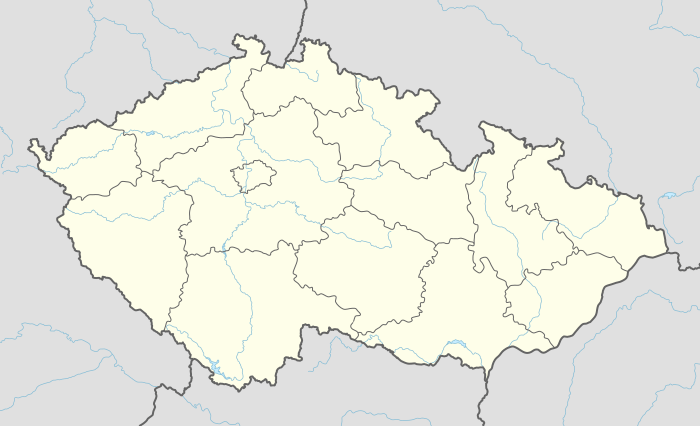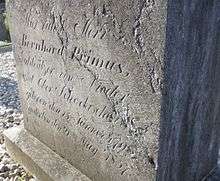Soběšovice
Soběšovice (Polish: Sobieszowice or Szobiszowice, German: Schöbischowitz) is a village in Frýdek-Místek District, Moravian-Silesian Region, Czech Republic. It has a population of 805 (2006). It is located on the shore of Žermanice Dam, in the historical region of Těšín Silesia.
Soběšovice | |
|---|---|
Village | |
Church in the village | |
 Flag  Coat of arms | |
 Location in the Czech Republic | |
| Coordinates: 49°43′47″N 18°27′55″E | |
| Country | Czech Republic |
| Region | Moravian-Silesian |
| District | Frýdek-Místek |
| First mentioned | 1305 |
| Government | |
| • Mayor | Petr Voznica |
| Area | |
| • Total | 3.65 km2 (1.41 sq mi) |
| Elevation | 330 m (1,080 ft) |
| Population (2019)[1] | |
| • Total | 884 |
| • Density | 240/km2 (630/sq mi) |
| Postal code | 739 38 |
| Website | http://www.sobesovice.cz/ |
The name is patronymic in origin derived from personal name Sobiesz (Soběš). In Silesian German the beginning s + vocalis a or o was often transformed into sch sound, hence Schöbischowitz and so also in the past in Polish Szobiszowice (sz in Polish correspondents to š in Czech).[2]
History
The village was first mentioned in a Latin document of Diocese of Wrocław called Liber fundationis episcopatus Vratislaviensis from around 1305 as item apud Sobnonem (Sobisonem?).[3][4][5] It meant that the village was in the process of location (the size of land to pay a tithe from was not yet precised). The creation of the village was a part of a larger settlement campaign taking place in the late 13th century on the territory of what will be later known as Upper Silesia.
Politically the village belonged initially to the Duchy of Teschen, formed in 1290 in the process of feudal fragmentation of Poland and was ruled by a local branch of Piast dynasty. In 1327 the duchy became a fee of the Kingdom of Bohemia, which after 1526 became part of the Habsburg Monarchy.
The village became a seat of a Catholic parish, mentioned in the register of Peter's Pence payment from 1447 among 50 parishes of Teschen deanery as Sobieschowicz.[6] After 1540s Protestant Reformation prevailed in the Duchy of Teschen and a local Catholic church was taken over by Lutherans. It was taken from them (as one from around fifty buildings in the region) by a special commission and given back to the Roman Catholic Church on 25 March 1654.[7] The parish was not reestablished afterwards.

After Revolutions of 1848 in the Austrian Empire a modern municipal division was introduced in the re-established Austrian Silesia. The village as a municipality was subscribed to the political and legal district of Cieszyn. According to the censuses conducted in 1880, 1890, 1900 and 1910 the population of the municipality dropped from 949 in 1880 to 863 in 1910 with a majority being native Czech-speakers (growing from 97.7% in 1880 to 98.1% in 1900 then dropping to 89.5%) accompanied by a Polish-speaking minority (up to 1900 between 1.6% and 2.2% then 91 or 10.5% in 1910) and only in 1880 accompanied by German-speaking people (7 or 0.7%). In terms of religion in 1910 the majority were Roman Catholics (94.6%), followed by Protestants (5.4%).[8]
After World War I, fall of Austria-Hungary, Polish–Czechoslovak War and the division of Cieszyn Silesia in 1920, it became a part of Czechoslovakia. It was annexed by Nazi Germany at the beginning of World War II. After the war it was restored to Czechoslovakia.
The construction of Žermanice Dam on Lučina River in years 1951-1958 led to a partial flooding of Soběšovice and extraction of the eastern territory of the village to form a new municipality of Lučina in 1956.
References
- "Population of municipalities of the Czech Republic". Czech Statistical Office. 1 January 2019.
- Mrózek, Robert (1984). Nazwy miejscowe dawnego Śląska Cieszyńskiego [Local names of former Cieszyn Silesia] (in Polish). Katowice: Uniwersytet Śląski w Katowicach. p. 170. ISSN 0208-6336.
- Panic, Idzi (2010). Śląsk Cieszyński w średniowieczu (do 1528) [Cieszyn Silesia in the Middle Ages (until 1528)] (in Polish). Cieszyn: Starostwo Powiatowe w Cieszynie. pp. 297–299. ISBN 978-83-926929-3-5.
- Schulte, Wilhelm (1889). Codex Diplomaticus Silesiae T.14 Liber Fundationis Episcopatus Vratislaviensis (in German). Breslau.
- "Liber fundationis episcopatus Vratislaviensis" (in Latin). Retrieved 13 July 2014.
- "Registrum denarii sancti Petri in archidiaconatu Opoliensi sub anno domini MCCCCXLVII per dominum Nicolaum Wolff decretorum doctorem, archidiaconum Opoliensem, ex commissione reverendi in Christo patris ac domini Conradi episcopi Wratislaviensis, sedis apostolice collectoris, collecti". Zeitschrift des Vereins für Geschichte und Alterthum Schlesiens (in German). Breslau: H. Markgraf. 27: 361–372. 1893. Retrieved 21 July 2014.
- Broda, Jan (1992). "Materiały do dziejów Kościoła ewangelickiego w Księstwie Cieszyńskim i Państwie Pszczyńskim w XVI i XVII wieku". Z historii Kościoła ewangelickiego na Śląsku Cieszyńskim (in Polish). Katowice: Dom Wydawniczy i Księgarski „Didache“. pp. 259–260. ISBN 83-85572-00-7.
- Piątkowski, Kazimierz (1918). Stosunki narodowościowe w Księstwie Cieszyńskiem (in Polish). Cieszyn: Macierz Szkolna Księstwa Cieszyńskiego. pp. 263, 281.
External links
| Wikimedia Commons has media related to Soběšovice (Frýdek-Místek District). |
- (in Czech) Official website

